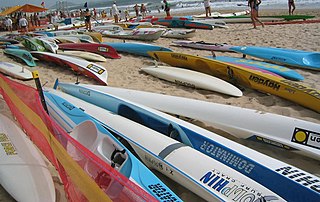
Surf lifesaving is a multifaceted social movement that comprises key aspects of voluntary lifeguard services and competitive surf sport. Originating in early 20th century Australia, the movement has expanded globally to other countries, including New Zealand, Ireland, South Africa, and the United Kingdom. Surf lifesavers in Australia are colloquially known as "Clubbies".

Nippers are young surf lifesavers, usually aged between 5 and 14 years old, in clubs across Australia, New Zealand and South Africa. Unlike senior surf lifesavers, the majority of them do not patrol the beaches. The focus for Nippers tends to be on fun, and surf awareness.
Surf Life Saving Northern Region is the largest of four regions that make up Surf Life Saving New Zealand. As of the 2021/2022 season, it is made up of 18 clubs that look after 22 patrol locations from Ahipara to Raglan on the West Coast and from Whangārei Heads to Takapuna on the East Coast.
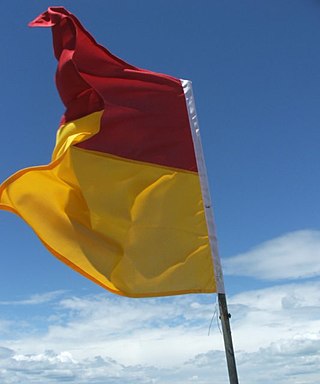
Surf Life Saving New Zealand (SLSNZ) is the national association representing 74 Surf Life Saving Clubs in New Zealand. The organisation's motto is 'In it for Life'. This refers to both the long relationship many members have with the organisation, as well as to the organisation's purpose of preventing drowning and injury, thereby saving lives.

Inflatable Rescue Boats (IRBs) are rubber boats with an outboard motor used in surf lifesaving. IRBs have been used for all forms of surf rescue, retrieval, and service by Surf Lifesaving in New Zealand, Australia, and Del Mar, California since the late 1980s.

Surf Life Saving Clubs are volunteer institutions at Australia's beaches. The clubs conduct surf lifesaving services on weekends and public holidays, and in the 2014-2015 season they saved 12,690 people. They also host many beach sport activities, such as Nippers, surf carnivals and other competitions. The SLSCs are responsible for the education of Lifesavers including operation of Inflatable Rescue Boats (IRBs) and maintaining radio communication with other beaches and air rescue resources.
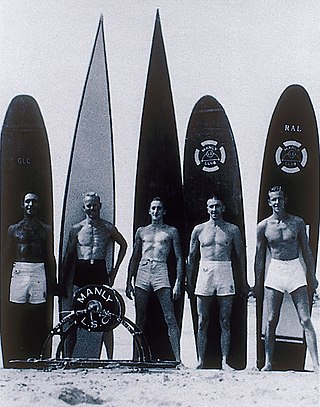
The Manly Life Saving Club is one of Australia's oldest Surf Life Saving Clubs, founded in 1911; located in the Sydney suburb of Manly, in the Northern Beaches Council in New South Wales.

Piha Surf Life Saving Club is a surf lifesaving club for the southern section of Piha, on the west coast of Auckland, New Zealand, some 45 km from the Auckland City centre. The patrol was featured in the TVNZ reality show Piha Rescue.
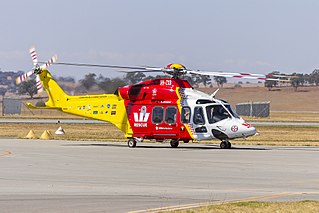
The Westpac Lifesaver Rescue Helicopter Service is a helicopter surf lifesaving service that operates in Australia.

Wanda Beach or Wanda is the northernmost patrolled beach at Bate Bay in Cronulla, Sydney, New South Wales, Australia. Green Hills or Green Hills Ridge is the name given to the Cronulla sand dunes, just north of Wanda.

The Coogee Surf Life Saving Club is a foundation member of the surf lifesaving movement in Australia. It was founded in 1907 by a group of concerned locals and has a proud history of no lives being lost whilst its members have patrolled. Coogee SLSC celebrated its 100-year anniversary in 2007, the Year of the Lifesaver.

Surf Life Saving Australia (SLSA) is an Australian not-for-profit community organisation that promotes water safety and provides surf rescue services.
Surf Patrol, Australia's Lifesavers is an Australian reality television series that airs on the Seven Network. The series is produced by the Australian production company Cornerbox, the producers of Seven's other factual series The Force and Border Security: Australia's Front Line. The first season was presented by Simon Westaway, with Naomi Robson taking over for season two, and Tom Williams for series three.
Redhead Surf Lifesaving Club is one of the oldest surf clubs on the New South Wales coast. Founded in 1908, it is located on Redhead Beach, in the suburb of Redhead about 15 kilometres (9.3 mi) south of Newcastle. It is affiliated with Surf Life Saving Australia, and its club colours are yellow and blue.
The Bondi Surf Bathers' Life Saving Club is Australia's oldest Surf Life Saving Club, founded in 1907. The club was officially established on 21 February 1907 at the Royal Hotel in Bondi Beach, Sydney, New South Wales. The clubs aim is to ensure "No Lives Lost" at Bondi Beach and is a volunteer organisation that patrols Bondi Beach from October to April every year.
The Palm Beach Surf Life Saving Club is an Australian Surf Life Saving Club. The Club offers a range of activities and encourages members to continually develop and update their lifesaving skills. It is located at the southern end of Palm Beach, New South Wales, and members provide voluntary patrols on weekends and public holidays. Its members participate in internal and external competitions. Palm Beach Surf Life Saving Club is a voluntary, non-for-profit organisation. It is considered that "if you have on your resume that you're a member of Palm Beach Surf Club, you've really made Sydney's social set."
The Wanda Surf Lifesaving Club was established in 1946 after World War II by a group of men who banded together, from the North Cronulla Surf Life Saving Club who were being asked to patrol this stretch of beach, being a considerable distance from the Cronulla area. The colours of Army red, Air Force blue, and Navy blue were adopted as the club colours. The club, located on Marine Esplanade, has grown in size to its current membership of over 900 male and female members, ranging in age from five-year-old Nippers to the original Founding Members.
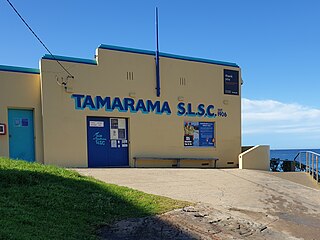
The Tamarama Surf Life Saving Club was founded in 1906 and operates at Tamarama Beach, Sydney. The clubhouse sits at the northern end of the beach.
The Freshwater Surf Life Saving Club, established in 1908, is located at Freshwater Beach in Australia. It has become a large volunteer organization with strong community bonds. The club was founded by a push from government to foster safer beach practices. It is a part of Surf Life Saving Australia, a not-for-profit organization committed to keeping the beach safe for patrons and providing beach rescue services. A visit to the club from United States' surfer, Duke Kahanamoku, in 1914 helped initiate the sport of surfing in Australia.










